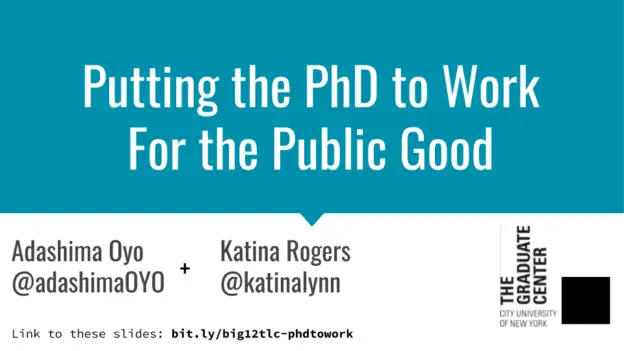I recently had the privilege of giving a joint keynote address at the Big XII Teaching and Learning Conference at the University of Texas, Austin, together with Adashima Oyo, doctoral student in social welfare, a graduate fellow in the Futures Initiative, and the director of HASTAC Scholars. Our goal in giving the talk was to situate the push for career preparation for doctoral students in a broader context of graduate education reform, including issues such as equity, inclusion, labor practices, and more.
Here’s the description we provided for the program:
Doctoral education opens doors to engaging and often unexpected pathways, with opportunities for significant public impact—an essential element of reinvesting in higher education as a public good. And yet, in many cases, faculty careers remain the default expectation. A number of programs are working to broaden students’ professional horizons, but it is not enough to talk about professional development in isolation.
The effort to prepare graduate students for careers beyond the classroom is most effective when it is embedded in a comprehensive discussion of the academic prestige economy, equity and inclusion, labor practices, and definition of scholarship. By providing thoughtful mentorship, material and intellectual resources, and flexible curricular and project design that considers the full landscape of graduate education today, faculty and administrators enable doctoral students to translate their skills and knowledge for different audiences and to conduct scholarly research that matters to their communities.
I’m sharing my part of the talk here. It contains some ideas that I’m still working through and hope to explore in more depth in future talks and writing. (Our complete slides are also available at bit.ly/big12tlc-phdtowork.)
Hello everyone. First, I would like to acknowledge that we gather today on the traditional ancestral and unceded lands of the Tonkawa and Numunuu people. I ask you to join me in acknowledging these communities, their elders both past and present, as well as future generations. I am a white woman of settler descent, and I know little about these communities or their protocols. While a land acknowledgment is not enough, it is something I am incorporating into my practice and hope that it provides a reminder that we are on settled Indigenous land, as well as an opening for all of us to reflect on ways to begin or continue supporting decolonial and Indigenous movements for sovereignty and self-determination.
I would like to thank the organizers, including Matthew Russell, Sarah Schoonhaven, Molly Hatcher, and Adria Battaglia, as well as everyone who helped make the conference happen, from facilities and catering staff to all the intellectual work that has gone into the day.
I’m delighted to be here with Adashima Oyo talking about something we both care about deeply: graduate education reform, career pathways, and higher education as a public good. Our premise is that training and supporting students to apply and connect their scholarship beyond the academy is essential to an understanding of equitable higher education, and to the reinvestment in higher ed as a public good. We hope that everyone here will leave with concrete ideas for what you can do right now at your home institutions to support both individual success and structural change—whether you are a student, faculty member, administrator, or any other role.
First, a little bit about our program, which has two parts: The Futures Initiative, based at CUNY, and HASTAC, an online network with administrative hubs at CUNY and Dartmouth.
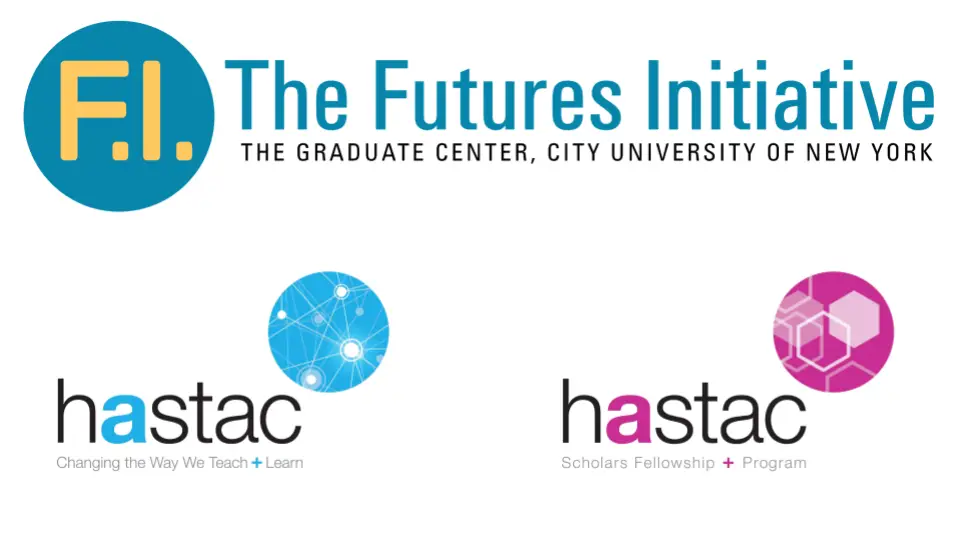
The Futures Initiative is a “think-and-do” tank that aims to design equitable futures in higher education. Our work begins with graduate students, who are in a dual role as both learners and teachers (especially since many students at the Graduate Center teach at one or more of CUNY’s 23 other colleges). We run team-taught graduate courses with a focus on equity and student-centered pedagogy; a public events series called the University Worth Fighting For; an undergraduate Leadership and Peer Mentoring program; and we conduct research and advocacy work related to the role of higher education in society. Our team of graduate fellows, including Adashima, is integral in every part of this programming. The fellowship is like an internship in academic administration, and lets grad students see behind the curtain to understand institutional workings that are often invisible to junior scholars.
HASTAC stands for the Humanities, Arts, Science, and Technology Alliance and Collaboratory. It is a social network and blogging platform that was founded in 2002 (before Facebook or even MySpace), and uses the mottos “dedicated to changing the way we teach and learn” and “difference is our operating system.” Adashima directs a subnetwork of about 200 graduate students, along with some postdoctoral fellows and undergraduates, who explore public scholarship through blog posts, collaborative projects, digital workshops, and more.
A little bit about my background: I have been working on graduate education reform for the last ten years, not only at CUNY but at places like the Alfred P. Sloan Foundation, the Scholarly Communication Institute (when it was based at the University of Virginia’s Scholars’ Lab), and the Modern Language Association. My work on the topic is both pragmatic—through the design and implementation of programs—and research-based.
I have written a book that will be published by Duke University Press in Fall 2020, called Putting the Humanities PhD to Work: Theory, Practice, and Models for Thriving Beyond the Classroom.
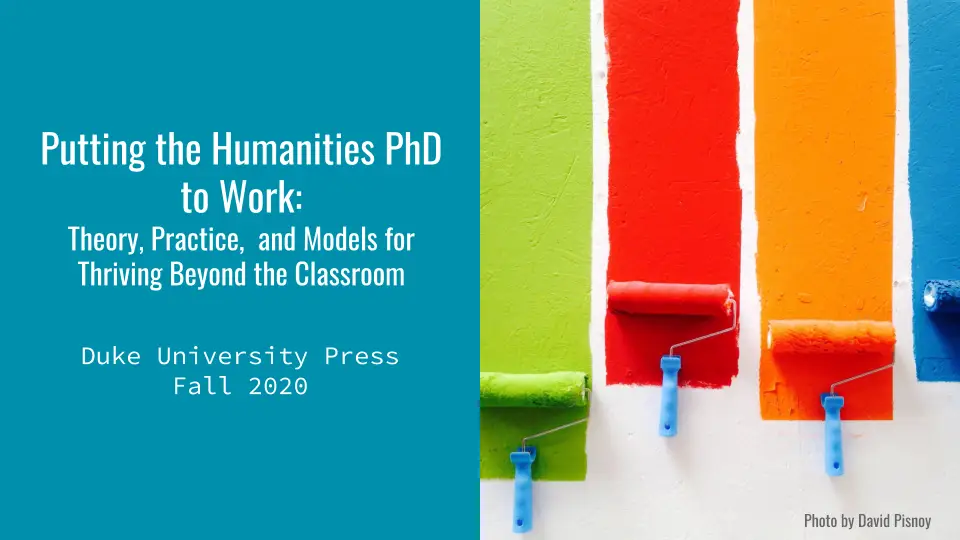
We’ll be hosting a free conference on the topic in May 2020, called Graduate Education at Work in the World, and we invite you all to submit proposals by Oct 15.
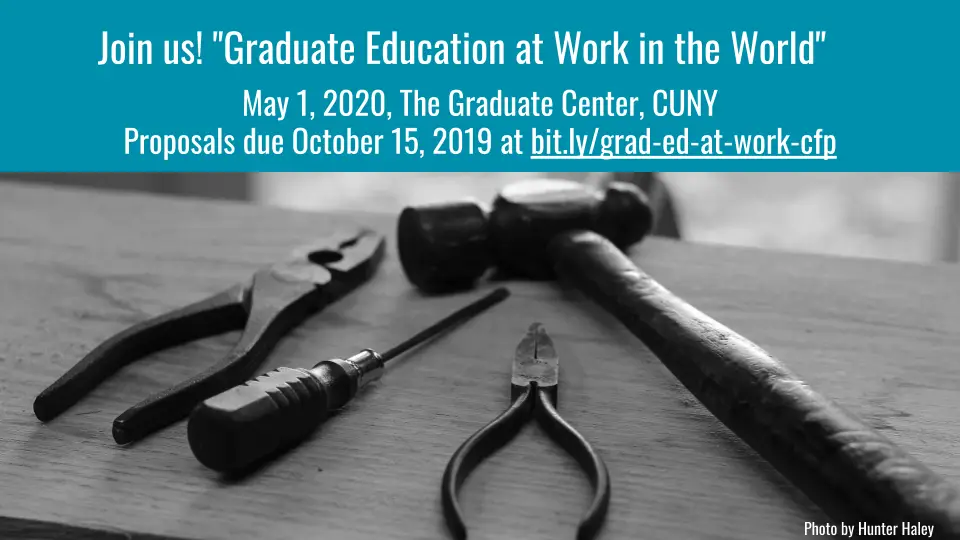
Our talk today builds on my research, Adashima’s research and experience, which she’ll talk about in a moment, as well as what both of us have seen and experienced through the Futures Initiative and HASTAC.
[At this point, we transitioned to Adashima, who led participants in a think-pair-share activity and then spoke compellingly about her educational experience. Adashima and I are working on transcribing the responses from the participatory activities, and hope to share some of them in a future blog post.]
Now, to shift back to the matter of graduate education and professional development, I want to first consider why “career diversity” matters.

I use scare quotes intentionally, because this is one issue: what do we call this thing we’re here to talk about? I don’t tend to use “alt-ac” anymore; while it once unsettled the binary of academic vs. nonacademic positions, I find that is is commonly used now in a way that reinscribes that same binary. (“Alt”-anything also feels like something to avoid in the current political climate.) Instead, I usually just talk about careers, plural, with faculty careers being one option among many—but the reality is still that faculty careers tend to be the default, so I often find we need to signal that we are talking about something else
I firmly believe that preparing doctoral students for a wider range of careers enables them to apply their research in new and meaningful ways. But I also hope that this work goes beyond individual success stories, towards deep-rooted structural change. My hope, far-fetched as it might sound, is that if programs genuinely commit to supporting creative, applied research, it may also be a way of improving the inclusivity of doctoral programs.
There are still so few faculty members from underrepresented backgrounds, especially from Black and Latinx communities. And this only gets worse as you go higher up in the academic hierarchy, as Adashima described based on her own experience as well as her research.
Attempting to recruit people of color is not enough—the structures must also be supportive and inclusive. One aspect of this support is recognizing the varied motivations and goals of people coming to academic programs from underrepresented backgrounds. Many aspire to find ways for their research to have a meaningful impact on their community—but the academy often doesn’t value or reward work of this nature.
My hope is that by broadening the range of what kinds of scholarship are formally rewarded and celebrated, and by expanding the kinds of career preparation students receive, programs may become more appealing to brilliant and creative scholars who don’t necessarily see a future for themselves in the professoriate. The impact of graduate education could be strengthened by such an approach—but it depends on making graduate education matter, with an emphasis on community and public engagement.
I am not proposing that we stop preparing students to teach, or that we try to draw students away from pursuing faculty careers. This is not an either/or proposition; interventions that support the kinds of skills that equip students to succeed in a wide range of job settings—such as project management, collaboration, and communicating to different audiences—are also incredibly beneficial to those who do become faculty members, helping them to be more effective in their teaching, research, and administrative responsibilities. But while talking about career pathways is important, it will never be more than a band-aid unless it is embedded in a broader discussion of academic structures and values. The conversation and action MUST go deeper than jobs alone.
A broader understanding of postgraduate success might improve the health and inclusivity of the humanities. But for this to be a reality, the discussion of professional development must be a part of wide-ranging discussion and efforts to improve things like academic labor conditions; bias around race, ethnicity, gender, disability, and sexuality; student debt and material support for graduate students; mentorship and mental health support; and more.
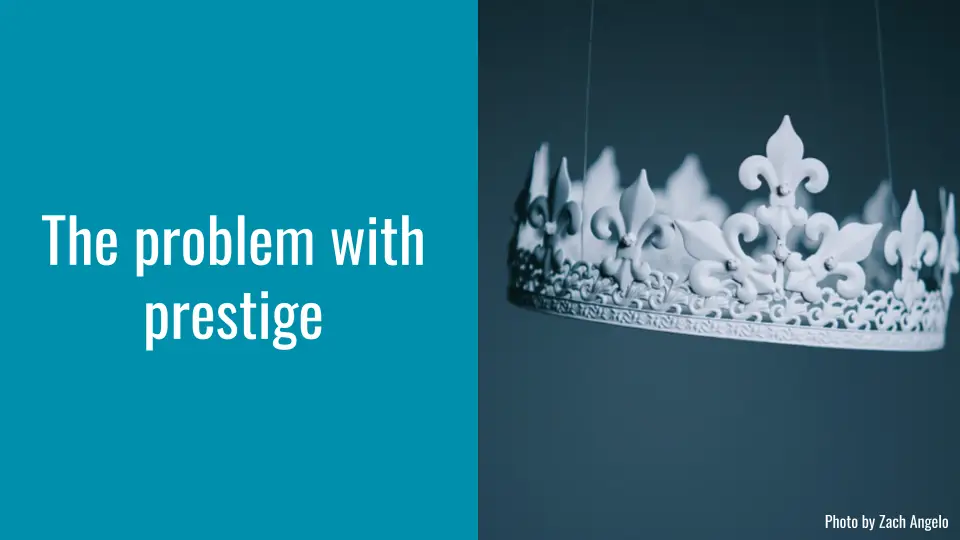
The areas where reform is needed are connected to the problem with prestige.
The prestige economy of higher education is often something that is a tacit undercurrent that propels and silently shapes both personal and structural decisions. From selecting a research topic, to student and faculty recruitment, to broader questions of institutional investment in particular programs or fields, there is nearly always an awareness of how such decisions will affect the relative prestige of the scholar, department, or university. That this would be the case seems impossible to change; it is part of “the way things are.”
But the pursuit and glorification of prestige has a deep impact on the way scholars work. For that reason, all who are invested in higher education must be willing to look directly at the role of prestige in academia, and to think critically about what constitutes scholarly or academic success. Until academics are able to think more expansively about that, it will be very difficult to make headway on meaningful reform efforts, whether those efforts are centered on improving diversity and inclusion, supporting labor issues, reinvesting in teaching, broadening career pathways, or anything else.
There is an underlying sense of limited resources—and limited room at the top of the hierarchy—that drives a great deal of academic competition. The limited resources can be quite real—I see this daily at CUNY—but much of this emphasis on scarcity and competition is also, I think, connected to a legacy of white supremacy disguised as meritocracy.
I am a white woman, and as Adashima noted, my positionality has a bearing on my experience and perspective. I can come to a conference like this one and expect to feel comfortable, and to see many people who look like me. Lately, I have been working to examine my own assumptions and privilege. I have been looking to feminist scholarship by Black women, Indigenous women, and women of color whose research and writing has long pointed towards the ways that generosity, abundance, hope, and joy can form a foundation on which educational principles are grounded.
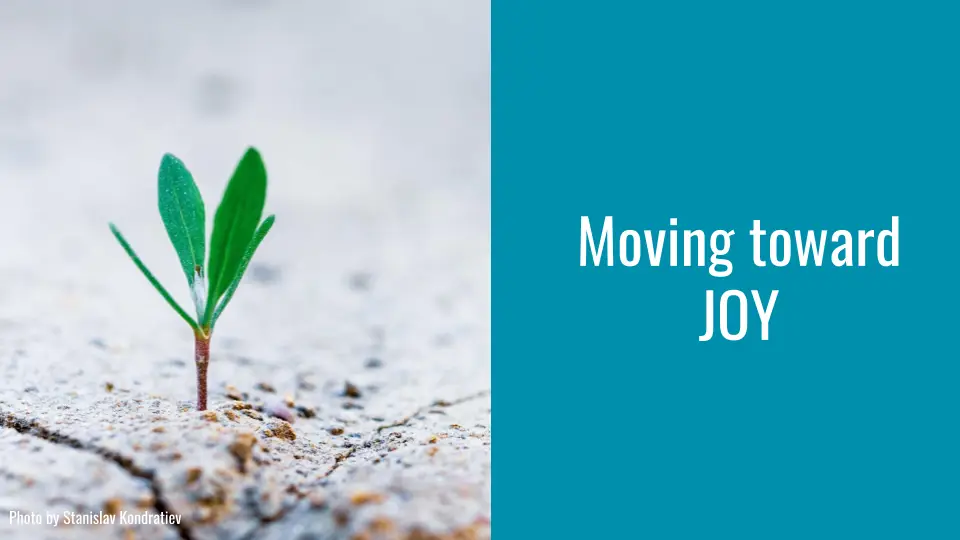
I look to scholars like Bianca Williams at CUNY who writes about happiness and vulnerability, and Cynthia B. Dillard at the University of Georgia, who writes on joy, friendship, and scholarship. From scholars like bell hooks, who reminds us that teaching is a fundamentally hopeful act; as well as Toni Cade Bambara, Cherríe Moraga, Gloria Anzaldua and many others I am coming to learn the importance of developing a praxis of hope and joy, even (and especially) in difficult times, as part of the work of building more equitable educational systems that work toward the full participation and agency of all students.
Scholarly work is all about creating new knowledge, new ways of being, new possibilities. Such goals could create a mindset of curiosity and abundance. But shifting from a prestige-oriented system to one that is fundamentally rooted in abundance and generosity would require a massive change not only in values, but also in the structures that have been developed on the basis of those values. This is something that Kathleen Fitzpatrick explores in her recent book, Generous Thinking.
So joy is where I hope to go from here—both in my own scholarship, and in the way I develop (and advise others to develop) programs.
At the Futures Initiative, we strive to create a program that is grounded in trust, collaboration, and material, intellectual, and emotional support. We do this because those are some of the necessary preconditions for joy, for sustainability, and—in my opinion—for meaningful scholarship and teaching.
All of this is why many efforts toward professional development in graduate programs ring hollow. It is not nearly enough. Real reform requires looking not just at the blossoms, but at the roots and stems that create the systems of graduate education.
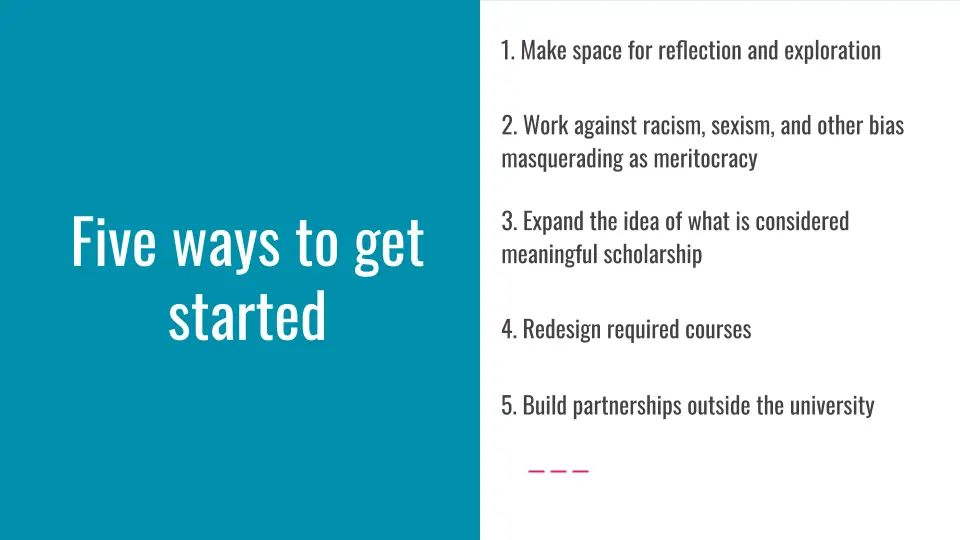
That may sound daunting, but there are ways to get started right now, whether at an individual or programmatic level. These are my top five ways to begin—ideally from the earliest days of grad school, but it’s also never too late to get started.
(1) Make space for exploration and reflection
Graduate school can be all-encompassing. Despite—or perhaps because of—that, it is deeply valuable to seek ways to stay connected with skills, interests, and communities that are not necessarily reflected in traditional academic work. Faculty members and administrators, you can make space for this kind of reflection by encouraging students to lead balanced lives. One way to do this is by asking questions—from the very earliest stages of graduate school—that make it clear that it is a good and normal thing to have commitments outside of the department. Ask open-ended questions and help students to see possible connections between their emerging scholarly interests and the things that motivate them in other ways.
(2) Work against racism, sexism, and other forms of bias in individual and systemic ways
White scholars especially must learn to notice and work against systemic racism and sexism in our institutions and in the academy. Graduate students are under intense stress that can negatively affect physical and mental health, not to mention academic performance. This is even more true for students whose identities are historically underrepresented in the academy.
Critically examining problematic tendencies within a program is an important first step to developing a more fully inclusive institution that welcomes diverse backgrounds, varied perspectives, and new forms of knowledge. The systemic racism and widespread bias of academic institutions and value systems means that faculty, students, and the public are generally learning from those who are in dominant cultural positions. To educate students in the fullest sense of the term, universities must become places where people from all backgrounds can question, challenge, explore, and articulate new views without fear of retribution.
(3) Expand the notion of what constitutes meaningful scholarship—and how it can be evaluated
Peer-reviewed journal articles and scholarly monographs are not the only way to share research—far from it. Graduate students and faculty members have many opportunities to push the boundaries of how to meaningfully share research. If you are in a position to do so, help pave the way for more junior scholars to work creatively. Lobby for the acceptance of non-traditional dissertations. Train faculty in how to evaluate innovative work. Support tenure cases for scholars who take risks, engage with different audiences, and connect with varied communities. Since prestige remains the coin of the realm for universities, finding ways to formally value public-oriented work is essential.
(4) Redesign required courses
If your program has required introductory or research methods courses as part of its curriculum, take a close look at the skills, values, and paradigms that it introduces to new students. Consider reshaping such courses to offer opportunities to students to think in a translational way about their program of study. Without sacrificing rigor or content, embedding the course in a broader context that reaches beyond the discipline and even beyond the academy can lead to deeper connections down the road. The course can be even more powerful if it adds a public-facing or collaborative project component, as students will begin to learn the power of working together toward a common goal that has a clear potential impact.
(5) Build partnerships outside the university
Which organizations and industries are important to the community where your institution is located? Consider finding ways to connect with them, either formally or informally. Rather than simply making the organization an object of study, invite them to join as collaborators and co-creators. As a corollary, be open to learning from many different sources—not just those that are formally academic in nature. Spending time listening to and learning from local communities, nonprofits, activist groups, journalists, and others can give scholars a more balanced and grounded perspective on research.
More than anything, whatever approach you take, strive to be a voice for change.
Higher education needs your support, so join others in working toward meaningful reform. Use opportunities for speaking and writing to lift up the work of those around you. If you have a union, get involved so that you can get a sense of how your goals and concerns fit in with those of the broader institutional community. Speak up about problematic departmental policies. However you choose to get involved, and even if change is hard to see, know that your voice matters every step of the way.
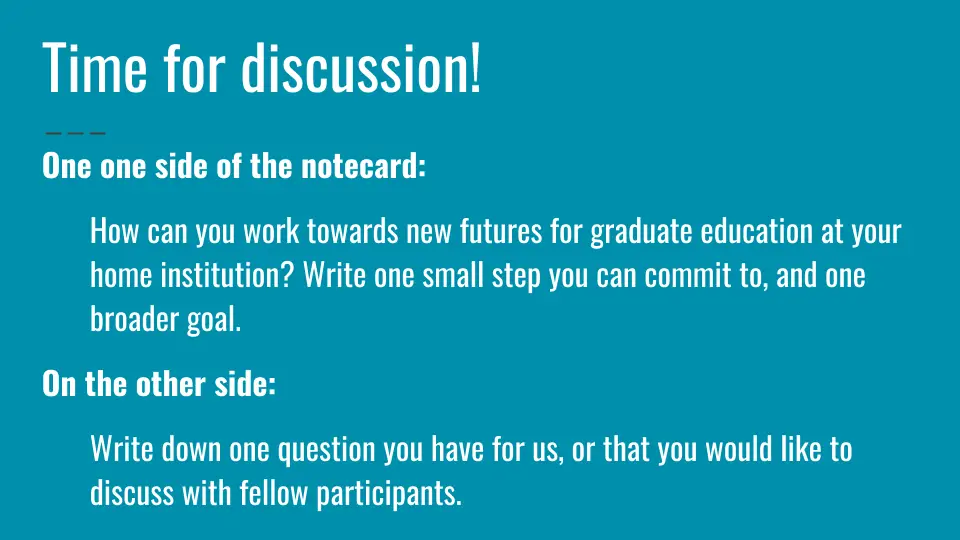
With all this in mind, I would like to return to another collaborative exercise to think together about where we might go from here.
Reflect on what kinds of interventions are already underway at your institution. Then, on your notecard:
- First, write down two ways you will work towards new futures for graduate education. Write one small step you can commit to, and one broader goal.
- Then, write down a question you have, either for us or for participants in the room.
- After sixty seconds, turn to the person next to you and share your goals and your question.
- Finally, we will regroup to discuss both concrete next steps, future goals, and questions.
Thank you all for your participation, energy, and thoughts! And thank you again to the organizers for inviting us to speak with you today. I look forward to seeing what emerges from our time together as we all work toward designing more equitable futures in higher education.
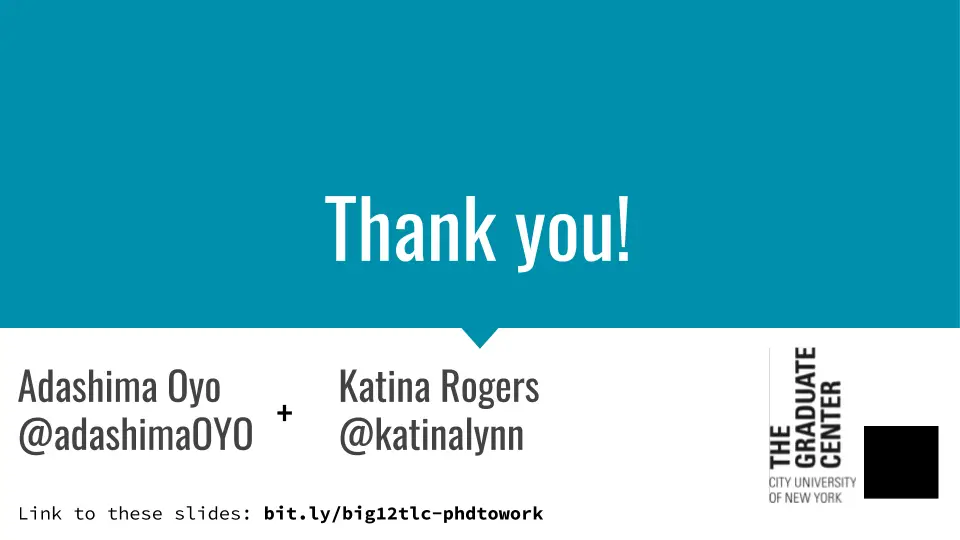
References
Bonetti, Kay. “An Interview with Toni Cade Bambara.” In Conversations with Toni Cade Bambara, 35–47. Literary Conversations Series. University Press of Mississippi, 2012.
Dillard, Cynthia B. “To Experience Joy: Musings on Endarkened Feminisms, Friendship, and Scholarship.” International Journal of Qualitative Studies in Education 32, no. 2 (February 7, 2019): 112–17. https://doi.org/10.1080/09518398.2018.1533149.
Fitzpatrick, Kathleen. Generous Thinking: A Radical Approach to Saving the University. Baltimore: Johns Hopkins University Press, 2019.
hooks, bell. Teaching Community: A Pedagogy of Hope. New York: Routledge, 2003.
Moraga, Cherríe, and Gloria Anzaldúa, eds. This Bridge Called My Back, Fourth Edition: Writings by Radical Women of Color. 4 edition. Albany: SUNY Press, 2015 (Kitchen Table: Women of Color Press, 1981).
Williams, Bianca C. The Pursuit of Happiness: Black Women, Diasporic Dreams, and the Politics of Emotional Transnationalism. Durham: Duke University Press, 2018.

